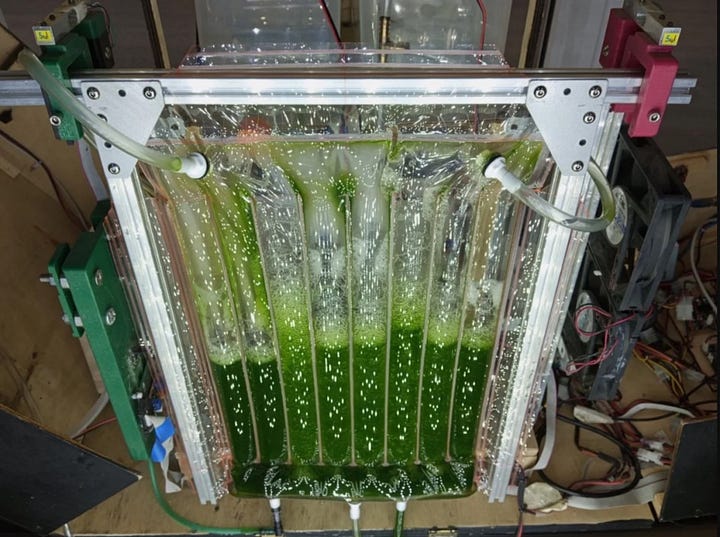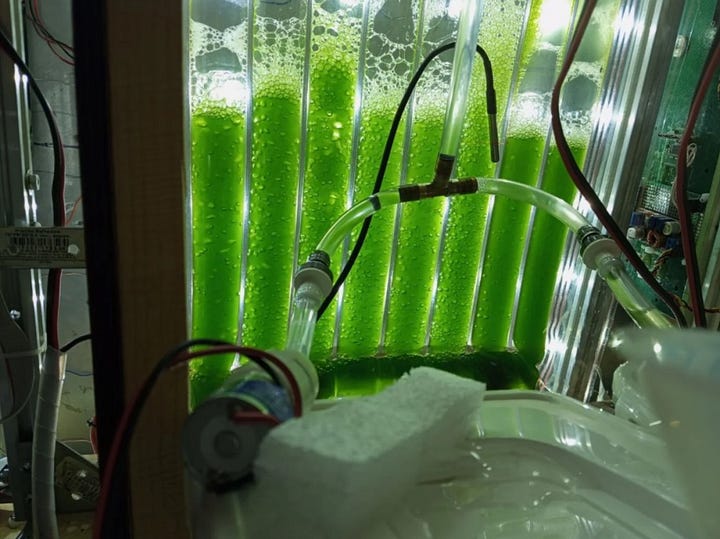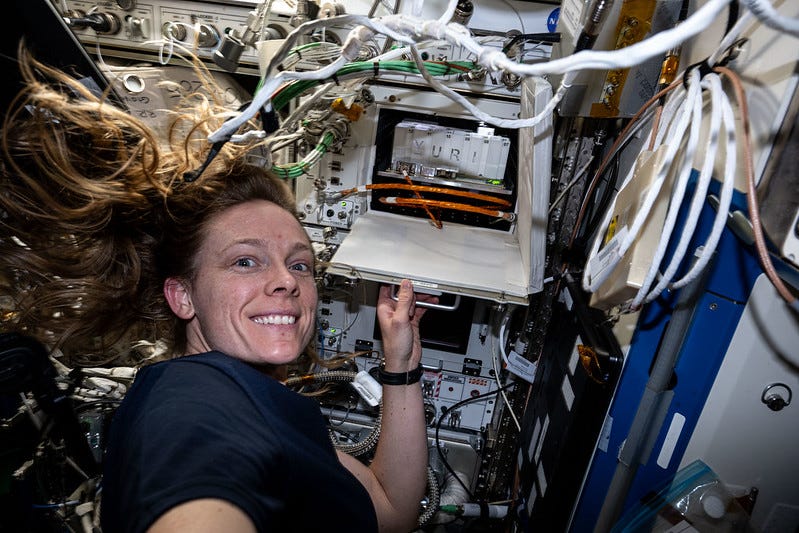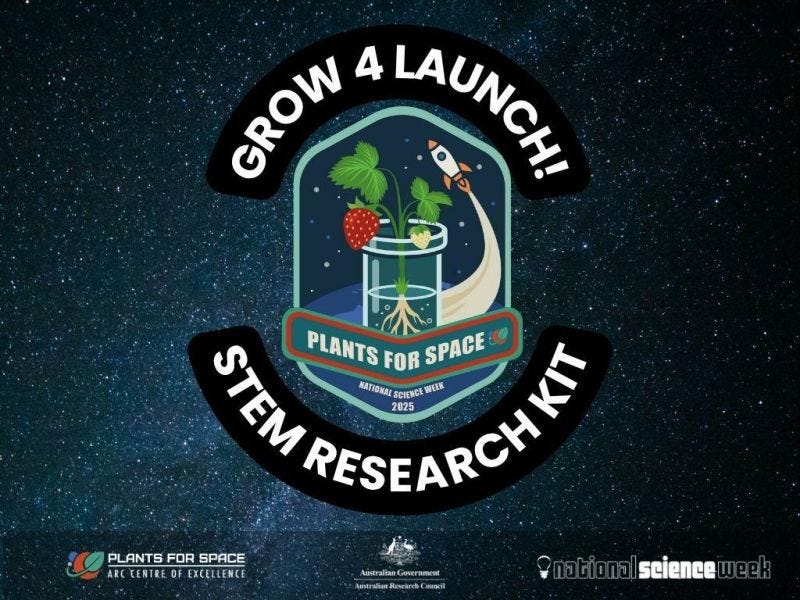Gardeners of the Galaxy Mission Report: 1 July 2025
My Top 10 Stories from the world of space plants and gardening. This week we've got space bioreactors, a cultural crop seed payload, anthocyanins and synthetic lichen on Mars!
Hello, Gardeners of the Galaxy! Welcome to this week's Mission Report.
1: Russian Scientists Revive Soviet-Era Photobioreactor Project for Space and Earth


According to TASS, Russian scientists are developing a photobioreactor to support astronauts in bases on the Moon and Mars.
"We’ve already started development, and there are prototypes. The project itself is based on Soviet-era research into photobioreactors for lunar bases. At that time, leading institutes were working on the challenge of closed-loop life support systems. Our goal is to revive their work, integrate modern technologies, and create a self-sustaining ecosystem," said Ilya Chekh, founder of the scientific and technical guild Frontiers of Science (Rubezhi nauki). "By the 1980s, they had achieved a very promising resource replenishment rate — around 80%. Unfortunately, the project was shut down due to low energy efficiency. Now we are reviving it as our flagship technological initiative."
Although the photobioreactor is primarily intended for space stations and bases, there are Earth applications as well, with several companies expressing interest in using the equipment to recycle carbon dioxide in office and factories.
According to project manager Alexander Shaenko, the key component of the bioreactor is microalgae, which produce oxygen, absorb carbon dioxide and purify water.
"But a single photobioreactor won’t be enough to sustain a human — you can’t live on algae alone. That’s why the cycle also includes small crustaceans like Daphnia (water fleas), then fish, and finally, humans at the end of the chain,” he explained, emphasising that this kind of ecosystem setup could meet the needs of Earth colonists on the Moon or Mars.
The project team has assembled and begun testing of the air separation unit, a short-cycle adsorption system using zeolite to extract carbon dioxide from the air humans exhale. Shaenko says that the prototype photobioreactor could be ready for human testing by the end of the summer.
"We plan to be able to conduct the first tests with human participation this summer - for example, by the end of August. So that for about an hour a person could breathe the air that passed through these microalgae," he said. “I’ll be sitting in a full-face mask, and the air I exhale will go into an air separation unit. The carbon dioxide will then be sent to the microalgae, where it will be converted into oxygen — and that oxygen will be sent back to me.”
Sources:
TASS, В России начали разработку фотобиореактора для Луны и Марса, 11 April 2025.
TASS, Фотобиореактор для Луны и Марса испытают на человеке в конце лета, 12 June 2025.
2: High on their own supply
Wired ran a story on one of the payloads onboard MayaSat-1, which launched on the SpaceX Transporter 14 rideshare flight. Slovenian researcher Božidar Radišič sent approximately 150 Cannabis seeds into orbit, believing the species uniquely suitable for space agriculture. MayaSat-1 was included in the Exploration Company’s Mission Possible (MP) reentry capsule, and the plan was for it to complete three orbits over Earth’s poles and then return to Earth. Unfortunately, communication with the capsule was lost shortly before splashdown, and the payloads can’t be recovered.
Read more: Scientists Are Sending Cannabis Seeds to Space
3: Grow for Launch!
National Science Week is on the horizon in Australia, and the Plants for Space researchers are inviting people to imagine the future of food in space.
Your mission, should you choose to accept it, is to:
🌱 Use hydroponic units to grow plants from seed, investigate which conditions promote growth, and monitor changes in colour, size, and taste.
💭 Design a recipe for our community space food cookbook.
Interested in participating? Register now to receive your FREE kit. Kits are limited, so make sure to register early. Registration closes on July 28th.
Find out more: Grow 4 Launch
4: World-first cultural crop payload to fly to the ISS
Wheat seeds from Pakistan will soon be heading to the International Space Station (ISS). It sounds like a space breeding experiment, as Pakistani space engineer Mähd Nayyer expects the project to yield “evolutionary results concerning crop yield, quality, and resistance to climatic effects on Earth”.
The project is part of a collaboration between Jaguar Space and The Karman Project that brings together Armenia, Egypt, Nigeria, and Pakistan with the goal of connecting cultural heritage and scientific inquiry through space-based agricultural research.
The mission centres on seeds of historical and cultural significance. Egyptian cotton, Armenian pomegranate and Nigerian egusi melon will fly alongside the Pakistani wheat. The plants, integral to national identities and economies, will be sent to the ISS for a multi-day stay in microgravity, before returning to Earth for continued research and public engagement.
By studying how these culturally meaningful crops respond to spaceflight, the project aims to deepen understanding of seed resilience and plant biology in extreme environments - knowledge critical for both long-duration space missions and Earth-based challenges such as climate change, food insecurity, and resource scarcity.
Dr Luis Zea, Founder of Jaguar Space, says: “Integrating crops native to emerging space nations is essential for building a sustainable human presence beyond Earth. These collaborations advance nutritional diversity, preserve cultural identity, and open new scientific frontiers. Jaguar Space is proud to enable this progress and support the next generation of global space explorers.”
Read more: From earth to orbit, Pakistani wheat seeds heads to space, The Karman Project and Jaguar Space Unite to Launch World-First Cultural Crop Payload to the ISS
5: Anthocyanins protect seeds in space
The latest edition of NASA’s ISS Research Newsletter explains that after exposure to space outside the station, purple-pigmented rice seeds rich in anthocyanin had higher germination rates than non-pigmented white rice seeds. That suggests anthocyanin, a flavonoid known to protect plants from UV irradiation, could help preserve seed viability on future space missions. The results, part of the Tanpopo-3 investigation, were published in Life Sciences in Space Research earlier this year.
6: Building on Mars with synthetic lichens
At Texas A&M University, Dr Congrui Grace Jin and her colleagues have developed a synthetic lichen system that can form building materials with no outside intervention. Their latest study, funded by the NASA Innovative Advanced Concepts program and recently published in the Journal of Manufacturing Science and Engineering, applies this research to the autonomous construction of structures on Mars, using the planet’s regolith, which includes dust, sand and rocks.
“We can build a synthetic community by mimicking natural lichens,” explains Jin. “We’ve developed a way to build synthetic lichens to create biomaterials that glue Martian regolith particles into structures. Then, through 3D printing, a wide range of structures can be fabricated, such as buildings, houses and furniture.”
The design uses heterotrophic filamentous fungi as bonding material producers because they can promote large amounts of biominerals and survive harsh conditions much better than heterotrophic bacteria. These fungi are paired with photoautotrophic diazotrophic cyanobacteria to create the synthetic lichen system.
Read more: Growing Homes On Mars: Texas A&M Research Pioneers Autonomous Construction Using Synthetic Lichen
7: More microalgae life support research

8: Navajo weaving and microchips for the Moon
More than a thousand unsung women whose circuits helped man land on the moon have inspired two Kent artists to celebrate the historic moment of 1969.
Moon Landing, by weaver Margo Selby and composer Helen Caddick, is a 16m (52ft) handwoven textile suspended from The Trinity Chapel of Canterbury Cathedral, accompanied by an original score for six strings.
The tapestry is based on the female Navajo weavers who were employed for their perceived dexterity to make microchips in New Mexico in the sixties, which were used by NASA in the Apollo Guidance Computer.
The installation will remain in the chapel until 31 August.
Read more: Unsung women behind moon landing celebrated in art, Core memory weavers and Navajo women made the Apollo missions possible.
The contemporary company brochure those two article mention is available here, and Lisa Nakamura published “Indigeous Circuits: Navajo Women and the Racialization of Early Electronic Manufacture” in American Quarterly in 2014.
9: Take a cooling virtual hike in a vertical forest
Take a virtual break from the unrelenting heat with this photo story about a new tower block in the Netherlands, which has created a vertical forest with tens of thousands of plants.
Wonderwoods Vertical Forest in the Beurskwartier area of Utrecht brings new housing, office space and an estimated hectare of vertical forest to the area. The building can absorb carbon dioxide, reduce air pollution and provide a cooling effect, both in shady outdoor spaces and in the interiors, as well as supporting plant and animal biodiversity.
See more: A vertical forest growing in the Netherlands: in pictures
10: And watch Sally Ride take to the skies
If you haven’t seen it yet, I can thoroughly recommend ‘Sally’, the new documentary about NASA astronaut Sally Ride – the first American woman in space.
Don’t forget that I regularly post fresh content to my Space Botany website. This week you can read about a desert lichen that shows life may be able to thrive on Earth-like exoplanets, and Italy’s BIOMIRATE project to develop sustainable food and life-support solutions for astronauts on the Moon and Mars.
I'll be back in your inboxes next week. Thanks for reading and being part of the Gardeners of the Galaxy community.
Ex solo ad astra,
Emma (Space Gardener)





